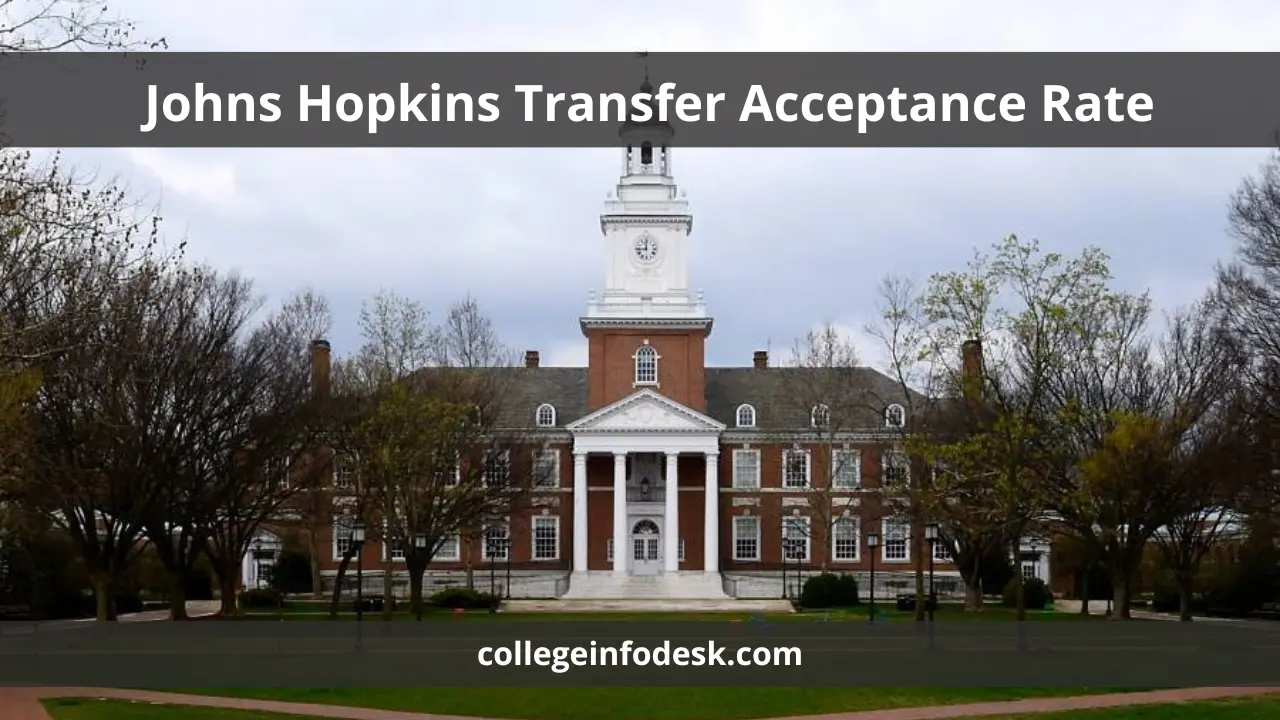Johns Hopkins University, situated in Baltimore, Maryland, stands among the elite colleges with a perennially single-digit acceptance rate, placing it in the league of Ivy-equivalent institutions. Given the competitive landscape, only a fraction of the 37,000+ applicants can secure admission. However, for those who did not secure a spot as freshmen, there’s still an opportunity to gain entrance to this prestigious university. While the transfer admission process remains highly selective, Johns Hopkins admits over 100 students annually through this avenue.
This blog aims to provide valuable insights into the Johns Hopkins transfer experience, including the transfer acceptance rate, the transfer deadline, application requirements, the transfer decision date, and other essential information. For individuals determined to make their mark at Johns Hopkins, understanding these key details is crucial to navigating the transfer application process successfully.
What is the Johns Hopkins transfer acceptance rate?
Here, we present both the most recent and historical data on the Johns Hopkins University (JHU) transfer acceptance rate.
For the fall of 2022, there were 1,634 transfer applicants, with 106 successfully gaining admission, resulting in a Johns Hopkins transfer acceptance rate of 6.4%. When segmented by gender, the acceptance rates are as follows:
- Male transfer applicants: 6.9%
- Female transfer applicants: 5.9%
In the fall of 2021, 1,927 transfer students applied, and 131 individuals were accepted, yielding a transfer acceptance rate of 6.8%.
While historical acceptance rates are not publicly disclosed by JHU, the university does provide insight into the average transfer acceptance rate across recent years, which hovers around 10%. This information offers valuable context for prospective transfer students considering their chances of admission to Johns Hopkins.
What are the Johns Hopkins transfer requirements?
The Johns Hopkins University transfer requirements encompass the following elements:
- Completed Common App for Transfer
- Submission of final high school transcript
- Provision of official college transcripts
- Common App College Report
- Optional inclusion of SAT or ACT scores
- One letter of recommendation from a current college instructor
Prospective students with the best chances of gaining admission to Johns Hopkins typically exhibit the following characteristics:
- Completion of at least 12 credits (equivalent to one full year of college coursework) prior to enrollment, enabling entry as sophomores or juniors.
- Attainment of near-perfect grades in their initial year at a community college or 4-year university.
In addition to a stellar academic record, noteworthy extracurricular achievements can significantly enhance an applicant’s profile. Given the sub-10% acceptance rates, showcasing exceptional accomplishments outside the classroom can play a pivotal role in setting applicants apart from the competition.
What is the JHU transfer GPA?
As per the university’s guidelines, a minimum 3.0 cumulative grade point average is a prerequisite for transfer applicants. However, similar to the evaluation process for first-year applicants, transfer candidates undergo a comprehensive assessment based on various criteria, including academic achievements, engagement, and the potential to contribute to campus life. From our observations, individuals with a GPA of 3.75 or higher tend to have significantly improved prospects during the transfer application process.
How hard is it to transfer to Johns Hopkins?
Admission for transfers is exceptionally competitive, contingent upon space availability and various considerations. The evaluation process is comprehensive, encompassing a holistic set of criteria such as academic accomplishments, engagement, and the potential to contribute to campus life. This underscores the rigorous and thorough approach Johns Hopkins University takes in selecting transfer students, emphasizing the significance of a well-rounded profile during the application process.
Is Johns Hopkins transfer friendly?
Here, we provide the latest Johns Hopkins University (JHU) transfer acceptance rate along with historical data. For the fall of 2022, there were 1,634 transfer applicants, and 106 successfully secured admission, resulting in a Johns Hopkins transfer acceptance rate of 6.4%.
Is Johns Hopkins generous to international students?
Johns Hopkins SAIS institutional scholarships are granted irrespective of citizenship, and numerous non-U.S. students are recipients of scholarships as part of their admissions offer. This highlights the inclusive approach of Johns Hopkins SAIS in extending financial support to deserving individuals, regardless of their nationality.
Is Johns Hopkins expensive?
While the annual cost of attendance stands at around $86,000, numerous families contribute significantly less, with some even covering no costs at all. Our commitment is to collaborate with you and your family, tailoring the financial arrangements to align with your specific circumstances and ensuring that the cost of education is manageable and accessible.
What is the JHU transfer decision date?
For fall enrollment, the decision date for Johns Hopkins University transfer applicants typically falls in mid-May. This key date provides prospective transfer students with valuable information about the outcome of their applications, allowing them to plan and prepare for the next steps in their academic journey at Johns Hopkins.
What is the Johns Hopkins Transfer Deadline?
Johns Hopkins University exclusively provides a fall transfer option. For those aspiring to transfer in the fall, the deadline for Johns Hopkins transfer applicants is March 1. This date serves as a crucial milestone for individuals planning to embark on their academic journey at Johns Hopkins and emphasizes the importance of adhering to the specified deadline for a seamless transfer application process.
Conclusion
While there are no mandatory courses for eligibility in a transfer to Johns Hopkins University (JHU), prospective applicants to both the Krieger School of Arts and Sciences and the Whiting School of Engineering will find recommended courses. Transfer candidates have the option to apply for a first-choice major as well as a second-choice major, with the exception of biomedical engineering, which is not available to transfers.
During the application review process, admissions officers consider various factors, including your high school record, college GPA, program of study, extracurricular activities, recommendations, and essay responses. The university is keen on understanding how applicants will integrate into the Hopkins community and why they are drawn to transferring here. If you approach the admissions process with outstanding grades and compelling reasons for choosing Johns Hopkins as your academic home, you stand a legitimate chance at acceptance.
